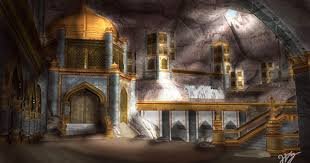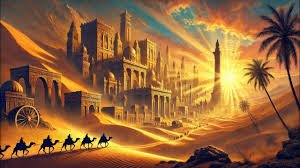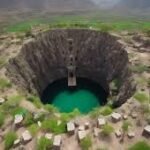Shrouded in the shifting dunes where Oman’s Dhofar region meets the UAE’s Empty Quarter lies one of archaeology’s greatest enigmas – the lost city of Ubar, celebrated in Bedouin lore as “Atlantis of the Sands.” This legendary frankincense trading hub, said to have been swallowed by the desert as divine punishment for its inhabitants’ arrogance, has tantalized explorers for centuries. Unlike other mythical lost cities, Ubar appears in multiple historical records including Ptolemy’s geography and the Quran’s Surah Al-Fajr, described as “Iram of the Pillars” – a place of towering architecture and unimaginable wealth. Modern satellite imaging and archaeological digs have revealed tantalizing evidence of a sophisticated caravan city buried beneath the sands, complete with collapsed wells and fortress walls that tell a story of sudden catastrophe. Yet the full truth remains elusive, hidden beneath the Rub’ al Khali’s ever-changing dunes, waiting to yield its secrets.
The Frankincense Connection: Ubar is Golden Age
Ubar’s legendary wealth stemmed from its position as the nerve center of the ancient frankincense trade between 3000 BCE and 300 CE. Historical accounts describe a city where “the scent of burning frankincense never faded,” with caravans carrying the precious resin to Mesopotamia, Egypt, and the Mediterranean. Recent excavations near Shisr (the suspected Ubar site) have uncovered bronze incense burners, trade seals from distant civilizations, and pottery fragments containing frankincense residue. Bedouin guides still point out faint trails in the desert – the remnants of the “Incense Road” where thousands of camels once passed. Archaeologists have mapped an extensive network of wells radiating from Shisr, suggesting a sophisticated water management system supporting a population of several thousand. Most intriguing are the accounts of Ubar’s “singing sands” – dunes that produced musical tones when disturbed, possibly from quartz crystals beneath, creating a natural alarm system against approaching caravans or raiders.
The Catastrophic Collapse: Fact and Folklore
Legends speak of Ubar’s dramatic downfall – some say due to divine wrath, others cite the city’s greed in hoarding water. Geological evidence reveals a more complex truth. Core samples show the region experienced a series of devastating earthquakes between 300-500 CE that collapsed the limestone caverns beneath the city, creating sudden sinkholes. Satellite radar has identified a massive subterranean cavity beneath Shisr’s ruins that may have been the “collapsed palace” described in early Islamic texts. Bedouin stories tell of a night when “the earth opened its mouth,” swallowing the city’s towering pillars whole. This aligns with archaeological findings of abruptly abandoned dwellings, with cooking vessels still in place and jewelry left behind. The discovery of a child’s skeleton in a collapsed tunnel, its arms wrapped around a frankincense pouch, offers poignant evidence of Ubar’s sudden demise. Modern seismologists confirm this area sits atop a still-active fault line, suggesting the earth may one day reclaim more of Ubar’s secrets.
Ubar: Lawrence of Arabia’s Failed Quest
T.E. Lawrence famously sought Ubar during his Arabian travels, calling it “the Atlantis of the sands” in his writings. His private journals (released in 2018) reveal he came closer than realized – he camped within 20km of Shisr in 1916 but turned back due to tribal conflicts. Local guides had warned him of “cursed ground” where compasses failed and men vanished. Modern analysis shows the area has strong magnetic anomalies that could disrupt navigation equipment. Lawrence’s notes describe hearing “ghost caravans” at night – camel bells and voices carrying across the dunes with no visible source, a phenomenon still reported today. His sketches of pillar-like rock formations match features near Shisr, suggesting he might have found Ubar had he persisted. The legendary explorer died believing the city was purely mythical, unaware how close he’d come to solving one of Arabia’s greatest mysteries.
NASA’s Role in the Modern Discovery
The breakthrough in locating Ubar came from an unexpected source – 1980s NASA space shuttle imaging. Scientists analyzing SIR-A radar data noticed faint geometric patterns beneath the sands near Shisr that suggested human-made structures. These images guided archaeologist Juris Zarins to the site in 1992, where excavations revealed an octagonal fortress with towers matching classical descriptions of Ubar. The NASA connection deepened when researchers realized the shuttle’s cameras had also detected ancient camel trails converging on the site – invisible from ground level but clear from space. Recently declassified Cold War-era U2 spy plane photos show the ruins more clearly, proving the structures were visible decades before their official discovery. Current satellite monitoring continues to reveal new features as dunes shift – in 2020, seasonal winds exposed what appears to be a ceremonial road lined with frankincense altars.

The Supernatural Reputation Among Bedouin
For generations, Bedouin tribes have avoided the Ubar area, believing it haunted by the “People of ‘Ad” – Ubar’s legendary inhabitants cursed to wander the dunes. Stories tell of ghostly caravan lights moving at night and disembodied voices calling in lost languages. Modern desert guides report GPS devices malfunctioning near the ruins, while geological surveys reveal localized magnetic disturbances. The most chilling accounts come from oil survey crews in the 1970s who described finding “fresh” camel tracks leading to solid rock walls, as if something had walked through stone. Some Bedouin still practice protective rituals when passing near Shisr – tying knots in their headscarves or reciting specific Quranic verses believed to ward off Ubar’s ancient curse. These traditions may explain why the ruins remained undisturbed for centuries despite their proximity to trade routes.
Ongoing Excavations and New Discoveries
Current archaeological work at Shisr continues to reshape our understanding of Ubar. Recent digs have uncovered a sophisticated water collection system using underground channels that cooled buildings naturally – an ancient form of air conditioning. In 2022, researchers found a sealed chamber containing perfectly preserved frankincense nuggets, their scent still potent after 1,500 years. Most exciting is the 2023 discovery of a possible astronomical observatory, with wall carvings that may represent celestial constellations. Ground-penetrating radar has revealed what appears to be an extensive underground network extending beyond the known ruins, prompting plans for cautious exploration. Meanwhile, linguists study newly found inscriptions that combine South Arabian scripts with unknown symbols, possibly representing Ubar’s unique dialect. Each discovery adds complexity to the picture of a cosmopolitan trading hub that connected ancient civilizations before vanishing into legend.
Visiting Ubar Today: Between Myth and Reality
The Shisr site (identified as Ubar’s most likely location) now features a visitor center with artifacts and interactive displays. Access requires a 4×4 vehicle and local guide through Oman’s Ministry of Tourism. The best time to visit is November-February when temperatures are bearable. Visitors describe an eerie atmosphere – the silence broken only by wind whistling through ruins, occasionally carrying what sounds like distant camel bells. At sunset, the low light reveals faint carvings on remaining walls showing frankincense trees and caravan scenes. While much of Ubar remains buried, standing at the edge of the main sinkhole where the city supposedly collapsed, one can almost hear echoes of its glory days – the bustle of traders, the scent of precious resins, and the inevitable whisper of the shifting sands that would claim it all.
The Eternal Allure of Arabia’s Lost Metropolis of Ubar
Ubar continues to captivate because it represents the ultimate archaeological mystery – a city simultaneously confirmed and elusive, its full story still buried. In an era when satellites map every inch of Earth, the fact that such a significant ancient metropolis could remain partially hidden speaks to the Rub’ al Khali’s power to guard its secrets. The city’s legacy lives on not just in ruins, but in the DNA of frankincense trees still harvested in Dhofar, in the camel routes now followed by modern highways, and in the enduring human fascination with civilizations lost to time. As excavation technologies advance, each grain of sand shifted may bring us closer to understanding Ubar’s true history – or reveal new layers of mystery that ensure the Atlantis of the Sands will keep its secrets a while longer.
Go to main page


